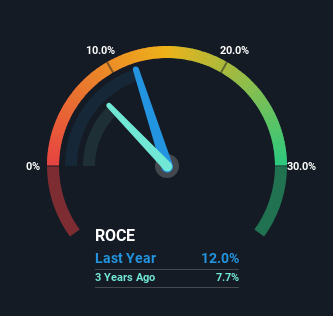Returns On Capital At Moog (NYSE:MOG.A) Have Stalled
What are the early trends we should look for to identify a stock that could multiply in value over the long term? Firstly, we'd want to identify a growing return on capital employed (ROCE) and then alongside that, an ever-increasing base of capital employed. This shows us that it's a compounding machine, able to continually reinvest its earnings back into the business and generate higher returns. So, when we ran our eye over Moog's (NYSE:MOG.A) trend of ROCE, we liked what we saw.
Understanding Return On Capital Employed (ROCE)
Just to clarify if you're unsure, ROCE is a metric for evaluating how much pre-tax income (in percentage terms) a company earns on the capital invested in its business. The formula for this calculation on Moog is:
Return on Capital Employed = Earnings Before Interest and Tax (EBIT) ÷ (Total Assets - Current Liabilities)
0.12 = US$365m ÷ (US$4.0b - US$1.0b) (Based on the trailing twelve months to March 2024).
Therefore, Moog has an ROCE of 12%. In absolute terms, that's a satisfactory return, but compared to the Aerospace & Defense industry average of 10.0% it's much better.
View our latest analysis for Moog
In the above chart we have measured Moog's prior ROCE against its prior performance, but the future is arguably more important. If you're interested, you can view the analysts predictions in our free analyst report for Moog .
What Can We Tell From Moog's ROCE Trend?
While the current returns on capital are decent, they haven't changed much. The company has employed 29% more capital in the last five years, and the returns on that capital have remained stable at 12%. Since 12% is a moderate ROCE though, it's good to see a business can continue to reinvest at these decent rates of return. Over long periods of time, returns like these might not be too exciting, but with consistency they can pay off in terms of share price returns.
What We Can Learn From Moog's ROCE
In the end, Moog has proven its ability to adequately reinvest capital at good rates of return. And long term investors would be thrilled with the 117% return they've received over the last five years. So while the positive underlying trends may be accounted for by investors, we still think this stock is worth looking into further.
On a separate note, we've found 1 warning sign for Moog you'll probably want to know about.
While Moog isn't earning the highest return, check out this free list of companies that are earning high returns on equity with solid balance sheets.
Have feedback on this article? Concerned about the content? Get in touch with us directly. Alternatively, email editorial-team (at) simplywallst.com.
This article by Simply Wall St is general in nature. We provide commentary based on historical data and analyst forecasts only using an unbiased methodology and our articles are not intended to be financial advice. It does not constitute a recommendation to buy or sell any stock, and does not take account of your objectives, or your financial situation. We aim to bring you long-term focused analysis driven by fundamental data. Note that our analysis may not factor in the latest price-sensitive company announcements or qualitative material. Simply Wall St has no position in any stocks mentioned.

